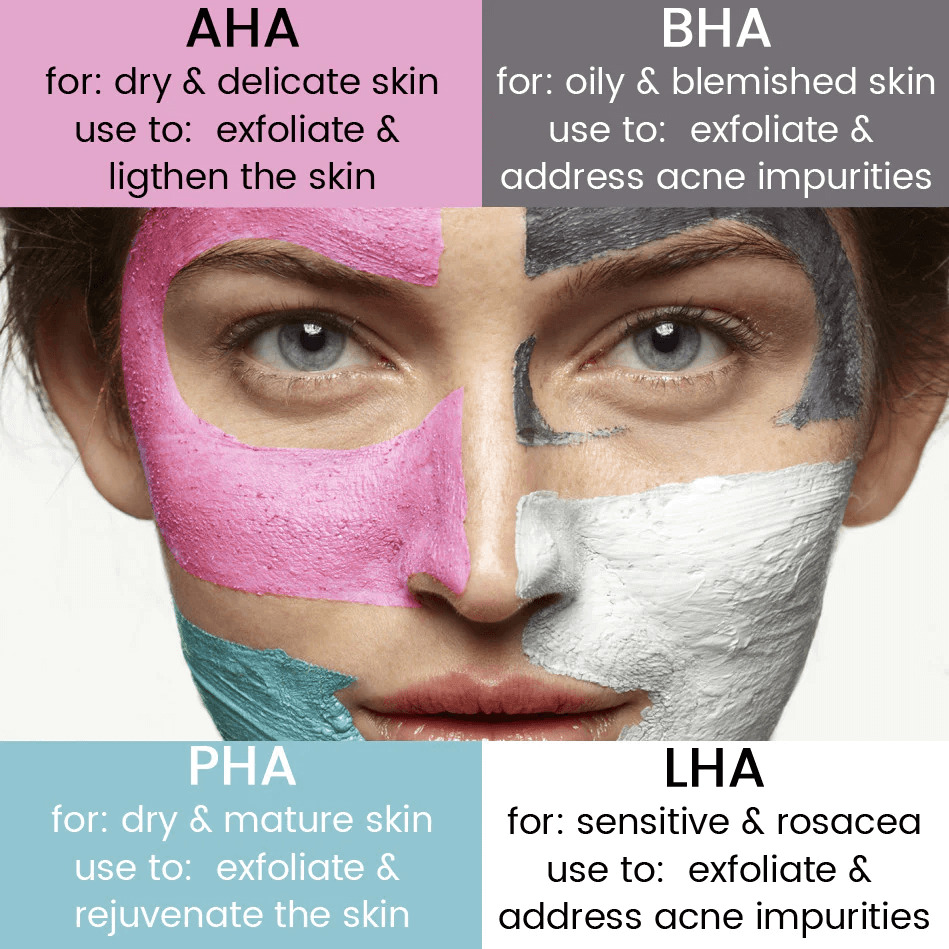If you’re on the quest for clearer, smoother, and more radiant skin, you’ve probably come across the terms AHA, BHA, and PHA. These three acronyms represent a group of chemical exfoliants that can revolutionize your skincare routine. But with so many options and so much information out there, how do you choose the one that’s best for your skin? Let’s break it down.

What is Chemical Exfoliation?
Chemical exfoliation involves using certain chemicals to remove dead skin cells, revealing the fresher and more radiant skin beneath. This is in contrast to physical exfoliation, which uses scrubs or brushes. Chemical exfoliants can be gentler, more effective, and offer additional benefits like hydration and collagen production.
Understanding AHAs (Alpha Hydroxy Acids)
Origin & Types: AHAs are water-soluble acids derived from sugary fruits. Common types include glycolic acid, lactic acid, and mandelic acid.
Benefits:
- Exfoliates the skin surface
- Boosts collagen production
- Fades discoloration and sun damage
- Improves skin texture and tone
Best for: Dry, aging, and sun-damaged skin.
Side effects: AHAs can make your skin more sensitive to the sun. Always use sunscreen when using products with AHAs.
Delving into BHAs (Beta Hydroxy Acids)
Origin & Types: BHAs are oil-soluble acids. Salicylic acid is the most commonly known BHA.
Benefits:
- Penetrates deeper into the pores, dissolving oil and buildup
- Reduces acne and blackheads
- Calms redness and inflammation
- Suitable for daily use for many skin types
Best for: Oily, acne-prone, and sensitive skin.
Side effects: Can cause dryness and peeling if overused. It’s essential to start slowly and observe how your skin reacts.
Peeking into PHAs (Polyhydroxy Acids)
Origin & Types: PHAs are the newest generation of exfoliants. Examples include gluconolactone, galactose, and lactobionic acid.
Benefits:
- Provides gentle exfoliation suitable for sensitive skin
- Offers hydration benefits
- Fights glycation, a process that weakens collagen
- Acts as an antioxidant, protecting skin from environmental damage
Best for: Sensitive skin and those new to chemical exfoliants.
Side effects: Fewer side effects compared to AHAs and BHAs due to their larger molecular structure, which means slower skin penetration.
How to Choose the Right Chemical Exfoliant
- Determine your skin concerns: If you’re dealing with surface roughness or sun damage, AHAs might be your best bet. For deeper pore congestion, BHAs are the champions. If you have sensitive skin, PHAs could be your ideal pick.
- Start slow: Begin with lower concentrations and less frequent applications to see how your skin reacts.
- Monitor your skin: Pay attention to any redness, peeling, or increased sensitivity.
- Mix and match carefully: Some people benefit from using a combination of these exfoliants, but it’s crucial to introduce them one at a time to understand how each impacts your skin.
H2: Key Takeaways
While all three types of chemical exfoliants—AHAs, BHAs, and PHAs—offer unique benefits, the best one for you depends on your skin type and concerns. No matter which you choose, remember always to wear sunscreen and give your skin time to adjust to the new product. With careful consideration and patience, you’ll find the perfect chemical exfoliant to unlock your most radiant skin.
